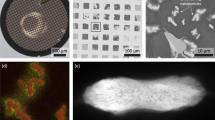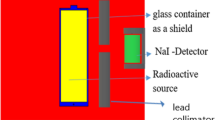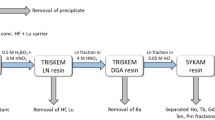Abstract
Some problems in nuclear physics and cosmic-ray astrophysics require a detector that can precisely identify one type of heavily ionizing particle against a background of other particles of higher or lower ionization rate. Films of polymers such as bisphenol acetone polycarbonate (for example, Lexan), polyethylene terephthalate (for example, Cronar) and allyl diglycol polycarbonate (for example, CR-39) are most commonly used for this purpose1. For some new applications, track detectors made of phosphate glass of suitable composition, chemically etched in an optimally chosen reagent, are proving to be much better than polymeric track detectors. One such application is the study of rare radioactive decay modes involving the occasional emission of a specific energetic nuclide such as 24Ne or 34Si in an enormous background of alpha particles or spontaneous fission fragments2,3. Another is the possibility of resolving neighbouring elements, or isotopes of a given element, in relativistic cosmic rays when the fractional difference in charge or mass is very small, as with Pb (Z = 82) and Bi (Z = 83), or 56Fe and 57Fe4. Here we present the results of a study of the relative sensitivities of a large number of phosphate glasses to relativistic ions of U, Au and La, indicating which ones are particularly useful for particle identification.
This is a preview of subscription content, access via your institution
Access options
Subscribe to this journal
Receive 51 print issues and online access
$199.00 per year
only $3.90 per issue
Buy this article
- Purchase on Springer Link
- Instant access to full article PDF
Prices may be subject to local taxes which are calculated during checkout
Similar content being viewed by others
References
Fleischer, R. L., Price, P. B. & Walker, R. M. Nuclear Tracks in Solids: Principles and Applications (University of California Press, Berkeley, 1975).
Barwick, S. W., Price, P. B. & Stevenson, J. D. Phys. Rev. C 31, 1984–1986 (1985).
Barwick, S. W. Thesis, University of California, Berkeley (1986).
Drach, J., Price, P. B., Salamon, M. H., Tarlé, G. & Ahlen, S. P. in Proc. 19th inter. Cosmic Ray Conf. Vol. 2 (ed. Jones, F. C.) 131–135 (NASA, Washington, D.C., 1985).
Fleischer, R. L. & Price, P. B. J. appl. Phys. 34, 2903–2904 (1963).
Aschenbach, J., Fiedler, G., Schreck-Kollner, H. & Siegert, G. Nucl. Instrum. Meth. 116, 389–395 (1974).
Ray, N. H. J. non-cryst. Solids 15, 423–434 (1974).
Wicks, G. G., Mosley, W. C., Whitkop, P. G. & Saturday, K. A. J. non-cryst. Solids 49, 413–428 (1982).
Price, P. B., Park, H. S., Gerbier, G., Drach, J. & Salamon, M. H. Nucl. Instrum. Meth. (in the press).
Author information
Authors and Affiliations
Rights and permissions
About this article
Cite this article
Price, P., Cook, L. & Markert, A. Phosphate glasses for identification of heavy ions. Nature 325, 137–138 (1987). https://doi.org/10.1038/325137a0
Received:
Accepted:
Issue Date:
DOI: https://doi.org/10.1038/325137a0
Comments
By submitting a comment you agree to abide by our Terms and Community Guidelines. If you find something abusive or that does not comply with our terms or guidelines please flag it as inappropriate.



